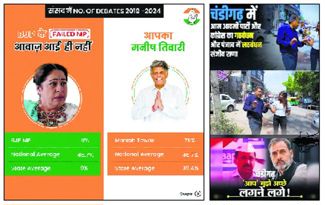
WITH assets surpassing Rs 54.5 lakh crore, India’s mutual fund (MF) industry is booming. Young investors and systematic investment plans (SIPs) are driving this growth. ISTOCK
Vijay C Roy
WITH assets surpassing Rs 54.5 lakh crore, India’s mutual fund (MF) industry is booming. Young investors and systematic investment plans (SIPs) are driving this growth. The SIP contribution in February hit a record high of Rs 19,186.58 crore, compared to Rs 18,838.33 crore in January.
Rajeev Kathuria, a mutual fund distributor, attributes the craze for MFs to handsome returns as compared to traditional savings instruments like PPF, FD or bank deposits. “Secondly, it’s a low-cost product where the investment starts from Rs 500 per month and an investor can also get tax benefits.” Most investors, he says, have to be educated about small and mid-caps as the industry is still marred by low financial literacy.
For over three years now, mutual funds that invest in small-cap and mid-cap stocks have been the favourite of investors. Small-cap stocks are defined as those with a market capitalisation of less than Rs 5,000 crore, while mid-cap stocks are those with market values ranging between Rs 5,000 crore and Rs 20,000 crore.
The bountiful inflows, in turn, prompted these funds to accumulate more small and mid-cap stocks. In the calendar year 2023, small and mid-cap schemes accounted for 40 per cent of the total net inflows into active equity schemes, receiving Rs 64,000 crore of the total inflow of Rs 1.6 trillion.
However, the growing MF pie in small and mid-cap stock ownership raised regulatory concerns regarding liquidity. Last month, the Securities and Exchange Board of India (SEBI) urged fund houses to stress-test their schemes to ascertain their ability to manage sudden surges in redemptions. This set off a correction in small and mid-cap stocks and levelled net asset values (NAVs) of funds.
The last calendar year saw a rally in the small and mid-cap segment with 48 per cent and 43 per cent returns in the respective segments and high liquidity as investors chased returns, according to Anand Rathi Wealth Limited.
Small and mid-cap stocks have been in the line of fire since the third week of March, with many counters hitting the lower circuit as there were only sellers.
According to Arvinder Singh Nanda, senior vice-president at Master Capital Services Ltd, the drop was a response to concerns raised by the market regulator regarding the overvaluation of mid-cap and small-cap stocks, leading to froth-building — where an asset’s price begins to increase beyond its intrinsic value. SEBI expressed apprehensions about potential frothiness in these segments, highlighting their exceptional performance and elevated valuations. The remarks sparked speculation about potential restrictions on fund allocation, causing disruptions in market sentiment.
“The crisis mushroomed from a number of factors, notably a heightened risk-aversion factor due to geopolitical uncertainties and overinflated stock values for small-cap stocks. SEBI’s stress test for mid-cap and small-cap mutual funds also increased pressure on these indexes,” says Gurmeet Singh Chawla, director at Master Capital Services Ltd.
SEBI’s warning
Last month, SEBI chief Madhabi Puri Buch said there is “froth” in small and mid-cap stocks owing to “off the charts” valuations. This, she pointed out, indicated price manipulation in the small and medium enterprises segment. She added that the regulator was willing to review norms that mandate small and mid-cap funds to invest 65 per cent of their assets in these stocks. According to Chirag Mehta, CIO, Quantum AMC, the SEBI directive came after the initial round of stress tests on small-cap and mid-cap schemes with large assets under management (AUM) to see if they can manage huge redemptions in the event of a market downturn.
“SEBI is looking to ensure that during phases of market downturns and the resultant surge in outflows, the first set of investors shouldn’t be at an advantage, leaving those staying invested with low liquidity,” he says.
Following the warning, the Association of Mutual Funds in India (AMFI) directed mutual funds to go for stress tests every 15 days and disclose the outcome. Earlier, SEBI had asked asset managers to give investors more information about risks associated with small and mid-cap funds.
No need to panic
According to Chirag Muni, executive director at Anand Rathi Wealth Limited, the stress test has brought clarity and investors do not need to panic. “This was a hypothetical crisis scenario created by SEBI. In the last 10 days, the mid-cap and small-cap segment has started recovering, with 3.9 per cent and 6.7 per cent returns. The categories are seeing an inflow in April after some outflow in March.”
In this fiscal year, while some small-cap stocks appear to be stretched, others still hold a significant growth potential. “We expect a good performance from select mid and small-cap entities,” says Chawla.
Chirag Muni is of the view that stress tests will be expected in the future to understand if the funds have improved their position. “We expect that asset management companies might restrict inflows in these categories and SIPs might pick up, which will regularise the liquidity. Investors need not worry and should create a balanced portfolio by investing across categories and market cap. A mix of 50-60 per cent in large-cap and rest in mid-cap and small-cap would be most ideal,” he adds.
According to Shashank Pal, chief business officer-wealth and investment products, Prabhudas Lilladher, “Mid and smallcap stocks fell in mid-March due to a combination of factors. On one hand, SEBI highlighted that froth is building up. It also directed AMFI to conduct stress tests. This made investors nervous and prompted many to exit, which pushed prices downwards.” On the other hand, he says, RBI issued directives against certain NBFCs, asking them to halt IPO financing and loans against shares. This could have impacted liquidity in the system.
According to Shashank, it may not be accurate to say that the fall has ended because mid and small-cap stocks inherently exhibit higher volatility and price swings. In the shorter term, they will continue to remain highly volatile and sensitive to all kinds of news affecting the markets. “Once the impact of the news or event is assessed and adequately factored in, the stocks begin to take direction.”
As new-age enterprises emerge, they will be classified within the small and mid-cap segment until they grow significantly larger over time, with predictable, large and stable cash flows, enabling them to transition to the large-cap space.
“Over longer periods such as three years, five years, and 10 years, mid and small-cap indices tend to outperform the Nifty 50 and Nifty 100 on a CAGR basis. Therefore, investors should not have a short-term horizon when investing in these stocks. They should be patient and allow investments to reap rewards over time,” Shashank adds.
What is a Stress Test
It determines the time within which the investor can recover the investment in the event of a downturn in the equity market and a subsequent surge in investor redemptions. Mutual fund companies conduct these stress tests to assess the liquidity of small and mid-cap portfolios. Every six months, the Reserve Bank of India conducts stress tests of banks to assess whether they will fall short of capital or liquidity if they face stress situations.
Mutual fund chronology
1963: MF sector starts with formation of Unit Trust of India (UTI). At the end of 1988, UTI has Rs 6,700 crore of assets under management (AUM).
1964: Unit Scheme 1964 (US ’64) is the first scheme launched by UTI.
1987: MFs set up by public sector banks, LIC and GIC enter market. SBI Mutual Fund is the first ‘non-UTI’ MF, followed by Canbank Mutual Fund, PNB Mutual Fund, etc. At end of 1993, MF industry has assets under management of Rs 47,004 crore.
1993: First set of SEBI regulations come into being for MFs, except UTI.
July 1993: Kothari Pioneer (now merged with Franklin Templeton MF) is the first private sector MF to be registered. By the end of January 2003, there are 33 MFs with a total AUM of Rs 1,21,805 crore.
2009: Following global meltdown, securities markets tank. Most investors lose money, faith in MF products is shaken.
Sept 2012: SEBI introduces measures to ‘re-energise’ MF industry.
2017: Flush with liquidity, banks cut FD rates after demonetisation. Equity market scales new highs.
Join Whatsapp Channel of The Tribune for latest updates.


























